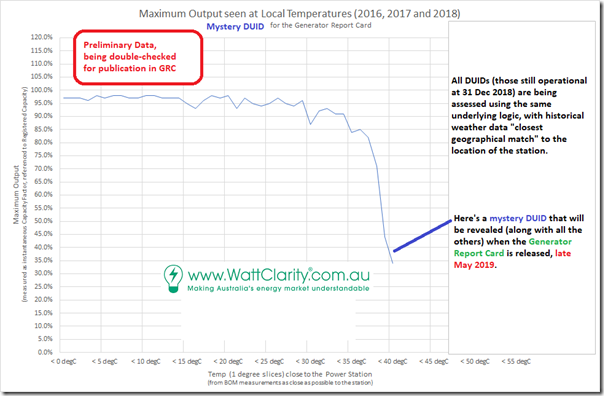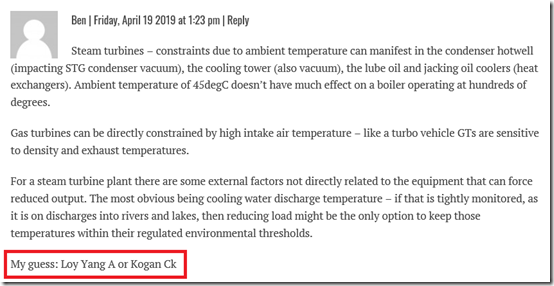* Please note that I’m not a big fan of terms like ‘can’t stand the heat’ as they tend to evoke emotional responses (which I can understand might be the objective for others). Given the growing complexities (and risks) inherent in delivering an energy transition that actually works, it seems to me that we’d be better off staying rational and objective with respect to a holistic view what the operational data is actually telling us – which is certainly what we’ve striven to do in preparing the Generator Report Card.
———————————
Frequent readers might remember that in April I posed a challenge for NEM observers in terms of guessing** which unit I’d featured as a “mystery DUID” was so significantly affected in output such that:
(a) its capability (in terms of peak output) was seen to start to decline from around 30 degrees local to the unit,
(b) with the capacity limitation severe from around 37 degrees Celcius.
** or statistically identifying, for those with the means and motivation
Here’s the output boundary curve for that “mystery DUID” again:
Since the release of the Generator Report Card on 31st May, I’ve received a few friendly nudges from people who were curious about which generator was the one featured here.
Those with their own copy of the Generator Report Card can see the result above on Page 85 in Part 4 (along with the results for the majority of the units in the cohort of similar units under the relevant Fuel Type in Part 4). I’m not going to share all those data points here today, but am happy to talk about this particular unit featured above…
(A) Clarifying what the chart shows
As discussed back in April, one piece of analysis we performed in compiling the Generator Report Card was:
Step 1 = to map each DUID to nearest BOM weather measurement station for which we have good data for the three year period 2016, 2017 and 2018 (as a result of this exercise, the farthest separation was something like 100km for some generator in Western Queensland – I believe this was Barcaldine).
Step 2 = with this mapping in place, assemble 2 linked series of data on a 5-minute basis (Output and Local Temperature).
Step 3 = normalise the instantaneous Output to instantaneous Capacity Factor, for easier comparability across all units.
Step 4 = for a given DUID, assemble a distribution of instantaneous Capacity Factor for each degree of Local Temperature.
Step 5 = choose the largest value of instantaneous Capacity Factor in each degree of Local Temperature; and
Step 6 = hence produce an “Output Boundary Curve” such as shown above.
Step 7 = repeat the process for all DUIDs that were operational across 2016 to 2018.
Step 8 = plot these curves for all DUIDs in a given fuel type, and include under the relevant Fuel Type heading in Part 4 of the Generator Report Card.
Those familiar with NEM analysis will understand that this exercise has identified a number of supplementary questions that could be the topic of follow-on analysis. Such questions have been posed in the Report Card.
(B) Why is analysis like this important?
We really should not need to be stated – however the fact that it does need to be clarified is just one more example of the mess we’ve been making of this energy transition, to date:
B1) We need much clearer, and broader, visibility
In the Generator Report Card, we discuss how the NEM is becoming increasingly dependent on the weather (Theme 6 in Part 2) and how, partly as a result of this, the level of risk in the NEM is escalating (Theme 2 in Part 2). It should be clear, therefore, that the energy industry needs much clearer and broader visibility of how the weather (and particularly the extremes in weather) can impact on all technology types in the generation sector – and an early warning system if such patterns were to materially change over time.
(a) This is true not just inside the core industry bodies (COAG Energy Council, ESB, AEMC, AEMO, AER, Government Departments, etc…) which, at their core, need a solid understanding of technical fundamentals that support the grid. Most of these organisations are now poring through the details within the Report Card (download your copy here), so that’s a great start.
(b) In the increasingly vocal space that is the broader group of energy sector stakeholders, we also need a deeper level of understanding – for in the absence of this we’ll continue advocating for “solutions” that won’t actually meet our needs moving forwards.
B2) … but have been poorly served, to date
Unfortunately, it’s been the view of the authors that the broader energy sector has been poorly served to date with analysis such as this – or such as the broader Generator Report Card in more general terms.
(a) As discussed in the Generator Report Card (Theme 14 in Part 2) the transitional challenges require greatly enhanced analytical capability.
(b) The little analysis that’s we’ve seen in this area, to date, has been fairly shallow in nature – and (in our view) a little too ideologically focused to have a real sustained benefit.
(C) If you thought coal (or thermal), you guessed wrong
Let’s get the main point out of the way, for a start – it was not a coal unit (or, indeed, any thermal plant) that was profiled as the “mystery DUID” as having such a marked limitation in output at high temperatures. Impatient readers can skip to (E) below to learn which it was.
Those with their own copy of the Generator Report Card (under each Fuel Type in Part 4) can see that each type of technology has its own specific profile of output limitations – which are more a function of the technology itself than the particular fuel that they use (though obviously there is some link).
(D) What were the guesses we saw?
Given the above as the starting point, we were not really too surprised to see a number of the guesses rolling in very wide of the mark. Again, just another demonstration that there’s quite a poor level of understanding of critical limitations (such as the above) across a broader group of energy sector stakeholders, including amongst prolific commentators who (we would hope) should know better.
At the time of writing this post, there were 14 comments at the bottom of the original article. Further afield, we also saw comments roll in over various platforms (including LinkedIn here, Twitter here (and elsewhere), and further afield on social media and in one-on-one contact).
D1) Those skewed towards thermal plant
There were a significant number of people whose guesses were skewed towards thermal plant – and particularly coal plant. The following are some of those guesses I was able to record, though note that the number was considerably larger – and that these ones are only included as examples to help readers here understand the “starting point” we’re facing in terms of helping people understand what’s actually happening:
Our suspicion has been that many (though not all) of people who are guessing coal and/or gas units might have been erroneously influenced by a very vocal #coalfail campaign that seems to have confused many people about what are the true limitations of coal plant.
D2) The Analysts
However there were a (albeit smaller) group of people who did contact me in various ways to submit their guesses that were actually based on real personal experience – and also (in even rarer occasions) had gone to the extent of performing some of their own analysis* to try to replicate what we’d done, and so were able to get much closer to the mark.
* If only there were more people in the NEM who’d actually do that, and not just blindly accept whatever is the most vocal group out there! A copy of the Generator Report Card would be a close second best option.
A special mention goes to Mike Hudson with this string of comments on the prior article on WattClarity:
(E) Which was the offending unit?
The “mystery DUID” was the Ararat Wind Farm – as this very astute contributor noted on Twitter:
Thanks Geoff!
E1) Some reasons why Wind Farms might be so significantly affected by high temperatures
As discussed in the Generator Report Card, there are a number of possible reasons that a wind farm might face such severe limitations in output at high temperatures (noting that these may, or may not, affect Ararat WF in particular):
Consideration #1) Remember that a number of wind farms are located in inland rural areas, which are more affected by extremes in temperatures than those located within the catchment area of coastal sea breezes.
Consideration #2) A number of turbine suppliers are European, and are known to have European-style “high temperature” protection systems that start affecting output at relatively low temperatures (by Australian standards). It might have been the case during construction that supplementary cooling systems were not added to gearboxes and so on…
Consideration #3) It is fairly well understood that the weather patterns in some parts of inland Australia that low wind speeds are tightly correlated with high temperatures. Hence wind farms located in these places would have energy resource limitations that deliver low output.
Consideration #4) It is also noted that transmission constraints might have bound consistently at high temperatures, hence limiting output at higher temperatures.
At the end of the day, from a system security point of view, it’s a secondary consideration which are the contributing factors in each case – the broader take-away is that Ararat Wind Farm:
(a) never saw output rise above 85% capacity factor when local temperatures were above 35 degrees, and
(b) saw output potential drop precipitously for each degree of temperature rise above that level.
E2) What’s the broader concern
We found other wind farms displaying similar characteristics (Mike Hudson hints at some above – see Part 4 of the Generator Report Card for some details) this should be a matter of serious further investigation, to ensure that we can take these limitations into account in the design of the system.
Given the number of DUIDs across the NEM (remembering that we performed this analysis across all DUIDs) we did not have time to drill into further details for specific DUIDs – though this surely should be something that the industry would have a crucial interest in, given that the NEM is likely to experience more extremes in temperatures moving forwards (Theme 2 in Part 2).
(F) Want to understand more about the Generator Report Card?
As noted before, we’re running some informal Q&A sessions as follows where you’re welcome to come along (if there are still spots available) to flip through a copy of the Generator Report Card in the following locations:
| Melbourne Q&A Session | Was already held on Tuesday 11th June.
However if you still have an interest, and are in Melbourne give us a call (07 3368 4064) and we can arrange something. Given that GVSC (our co-author) is based in Melbourne, it’s relatively easy to arrange a one-on-one meeting. |
| Adelaide Q&A Session | This was already held (Thu 27th June) in Adelaide. Thanks to those who attended! |
| Brisbane Q&A Session | Was already held on Tuesday 9th July in Brisbane.
We’re Brisbane-based, so give us a call (07 3368 4064) if you would like to meet, and flip through the Report Card. |
| Sydney Q&A Session (5pm start till 7:30pm) |
We’re still working to confirm the venue, for a session in Sydney on Monday 29th July.
Please register your interest for the Sydney session here (max 2 people per organisation*). |
* with all of these sessions, we won’t be providing a formal presentation (i.e. no big screen or talk, etc….) but
we do want to engage in one-on-one conversation with those who are interested in the Generator Report Card.
Hence we’d like to keep numbers down to a reasonable level, and ask that you register.
(G) End of Financial year?
It’s also worth noting (given it’s 26th June) that the end-of-financial year is fast approaching for many of us. Let us know if you need your invoice in the 2018-19 financial year when you provide your order.
—————————-
The above example (there are numerous others in the Generator Report Card) should provide a wake-up call to stop just parroting the pre-prepared lines of others who might not have completed analysis at the depth included in the Generator Report Card.
Available at a modest investment of only $3,000 exGST (providing access for your whole organisation), the Generator Report Card would give you a huge leg-up in understanding a diverse range of aspects of generator performance in Australia’s National Electricity Market. The Order Form is here.
———————————
Don’t forget to order your own copy today – or to register to attend our Q&A sessions in Adelaide (Thursday next week), Brisbane and Sydney coming up to have a chance to flip through a copy and ask us questions. Or call us directly on +61 7 3368 4064
















Does your analysis distinguish between a correlation of wind intensity with temperature and an effect of temperature upon wind generator performance?
Ha, good one! I hate being wrong but I like knowing the real answer too…
On reading this I immediately reviewed some old files I have for one of the grid connected wind farms in NSW, turns out there are several temperature sensors in the nacelle for the mechanical systems.
Below are the two high temperature alarms described in the technical documentation from the WTG supplier (in this case RePower). It is possible (and likely) there are others:
gearbox oil sump temperature
generator stator temperature